![]()
![]()
![]()
Use LEFT and RIGHT arrow keys to navigate between flashcards;
Use UP and DOWN arrow keys to flip the card;
H to show hint;
A reads text to speech;
23 Cards in this Set
- Front
- Back
|
bariatric |
Having to do with patients who are significantly overweight or obese |
|
|
Body mechanics |
The proper user of the body to facilitate lifting and moving to prevent injury |
|
|
Direct carry |
A method of transferring a patient from bed to stretcher, during which two or more rescuers curl the patient to their chests the reverse the process to let the patient to the stretcher |
|
|
Direct ground lift |
A method of lifting and carrying a patient from ground level try a stretcher in which two or more rescuers kneel, curl the patient to their chests, stand, then reverse the process to lower the patient to the stretcher. |
|
|
Draw sheet method |
A method of transferring a patient from bed to stretcher by grasping and pulling the loosened bottom sheet of the bed. |
|
|
Extremity lift |
A method of carrying a patient during which one rescuer skips hands under the patient's armpits and grasps the wrists, while another rescuer grasps the patients knees. |
|
|
Power grip |
Gripping with as much hand surface as possible in contact with the object being lifted, all fingers bent at the same angle, and hands at least 10" apart. |
|
|
Power lift |
A lift from a squatting position with weight to be lifted close the the body, get assist and flat on the ground, body weight on our just behind the balls of the feet, and back locked in. The upper body is raised up before the hips. Also called the squat lift position. |
|
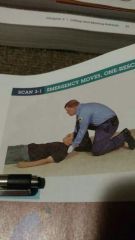
|
Clothes drag |
|
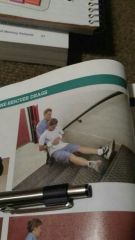
|
Incline drag |
|

|
Shoulder drag |
|
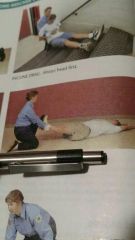
|
Foot drag |
|

|
Firefighter drag |
|

|
Blanket drag |
|
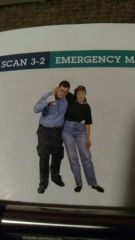
|
One rescuer assist. Place the patient's attn around your neck grasping her hands in yours. Place your other arm around the patient's waist. |
|

|
Cradle carry. Place one arm across the patient's back with your hand under her arm. Place your other arm under her knees and lift. If the patient is conscious, have her place her near arm over your shoulder. |
|

|
Pack strap carry. Have the patient stand. Turn your back to her, bringing her arms over your shoulders to cross your chest. Keep her arms as straight as possible, with her armpits over your shoulders. Hold the patient's wrists, bend, and pull hey into your back. |
|
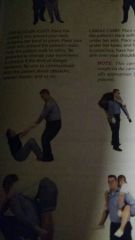
|
Firefighters carry. Place your feet against the patient's feet and pull her toward you. Bend at your waist and flex your knees. Duck and pull her across your shoulder, keeping hold of one of her wrists. Use your free arm to reach between her legs and grasp her thigh. This way, the weight of the patient falls into your shoulders. Stand up. Transfer your grip on her thigh to the patient's wrist. |
|
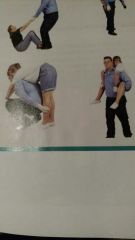
|
Piggyback carry. Assist the patient to stand. Place her arms over your shoulder si the cross your chest. Bend over and lift the patient. While she holds on with her arms, crouch and grasp each leg. Using a lifting motion to move her info your back. Pass your forearms under her knees and grasp her wrists. |
|
|
Types of patient carrying devices |
Power stretcher Portable stretcher Scoop (orthopedic) stretcher Basket stretcher Flexible stretcher Stair chair |
|
|
Body mechanic principles when reaching include: |
-Keep your back in a locked-in position -avoid twisting while reaching -avoid reaching more than 15-20"in front of your body -avoid prolonged reaching when strenuous effort is required |
|
|
Body mechanic principles when pushing or pulling include: |
-Push, rather then pull, whenever possible -Keep your back locked in -keep the line of pull through the center of your body by bending your knees -keep the weight close to your body -if the weight is below your waist level, push or pull from a kneeling position -avoid pushing or pulling overhead -keep your elbows bent and arms close to your sides |
|
|
Emergency moves should be considered in the following situations: |
-the scene is hazardous -care of life threatening conditions require repositioning -you must reach other patients |

